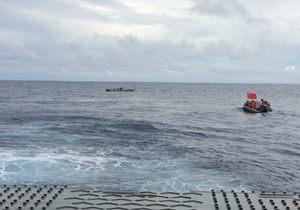Latest News
Search effort
Families' reaction
Timeline
Reporter's log
Infographic
Doubts
Airlines' statement
Photos
China's perspective
Experts say more development needed in nation's advanced maritime equipment
China has the ability to detect signals sent from deep in the sea, but the month-long hunt for missing Malaysia Airlines flight MH370 has exposed technological drawbacks in China's maritime search and rescue outfit, experts said.
Chinese patrol ship Haixun 01 picked up electronic pulsing signals in the Indian Ocean on Friday and again on Saturday. But some foreign experts are skeptical about whether China's equipment is advanced enough to obtain signals from as deep as 4,500 meters under the sea.
 |
"All of them were imported," he said. "The black box detector, which was made by the same company that produces black boxes, has a maximum detection range of 5,000 meters."
The adoption of such advanced technologies has enabled China to catch "ping" signals from the black boxes, he told Shanghai newspaper Jiefang Daily.
However, searchers need more time to analyze and verify the signals to see whether they are consistent with the black boxes - the flight data recorder and the cockpit voice recorder.
Many Chinese applauded Haixun 01's findings, but say China still lags behind other nations when it comes to maritime search and rescue equipment.
"I'm proud that it was our ship that first detected the (suspected) signals," said an Internet user who goes under the name biedong1925, "but it is a pity that none of the equipment used was made in China".
Some experts said more resources and investment should be allocated to China's maritime search and rescue outfit development.
"There are a lot of things that China should do to upgrade its equipment used in maritime search and rescue operations," said Cui Yiliang, an expert on ships and naval armament in Beijing.
"We must speed up the research and development of autonomous underwater vehicles, or AUVs," he said. "High-tech underwater vehicles such as the Bluefin-21 play an irreplaceable role in deep-sea detection and retrieval operations, but I haven't read any reports about similar equipment developed in China."
The torpedo-shaped Bluefin-21 underwater vehicle can operate to a depth of nearly 4,500 meters beneath the waves and is equipped with a variety of sonar equipment and cameras that can detect debris at great depths on the ocean floor. It transmits information about locations to nearby ships on the surface, according to the United States Naval Institute.
The Australian navy vessel Ocean Shield is carrying a Bluefin-21 in its current search and will use the sub to scan for wreckage once the black box is located.
AUV played a critical role in locating a lost Air France jet in 2011, two years after it crashed in the middle of the Atlantic Ocean. A team from the Woods Hole Oceanographic Institution in the United States used an AUV equipped with side-scan sonar to locate the aircraft about 3,900 meters underwater.
In China, the AUV is still in its infancy and far from being operational, Cui said.
In November, the Qianlong-1 unmanned autonomous underwater vehicle completed its first application test in the eastern Pacific Ocean.
Co-developed by the Chinese Academy of Sciences and Harbin Engineering University, it can travel to a depth of 6,000 meters, and is tasked to explore the seabed and collect hydrological data. The vehicle is on a trial run and marks the first time a Chinese AUV has been used for a scientific expedition, according to the academy.
Meanwhile, a military observer said the Chinese navy should improve its use of sea-based air platforms in maritime search and rescue operations.
The PLA navy's missile destroyer Haikou, replenishment ship Qiandaohu, and amphibian landing craft Kunlunshan and Jinggangshan are taking part in the search mission led by Australia in a remote part of the Indian Ocean.
However, the fleet "apparently failed to bring enough helicopters", said the observer in Guangzhou, Guangdong province, who declined to be named.
The two Arleigh Burke-class destroyers of the US Navy that had participated in the early search for MH370, the USS Pinckney and USS Kidd, each carried two MH-60R Seahawk helicopters, which flew sorties from dawn to dusk.
"Each Arleigh Burke-class destroyer can carry up to four helicopters, which means it has a strong capability to search on the sea," the observer said, adding Chinese destroyers and frigates can carry only one helicopter.
The amphibian landing craft Kunlunshan and Jinggangshan can each embark up to four helicopters, he said. "But judging from news reports, they didn't bring that number of helicopters. The only guess I can make is that our navy still needs to learn from the US Navy in the use of sea-based air platforms."
zhaolei@chinadaily.com.cn
 |
 |